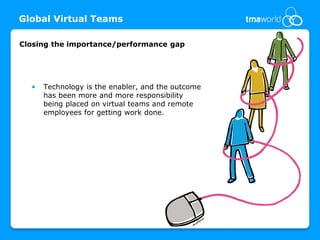TMA World Viewpoint Global Virtual Teams
- 1. Global Virtual Teams Closing the importance- performance gap TMA World Viewpoint
- 2. Global Virtual Teams Closing the importance/performance gap • A revolution is going on in the workplace due to the intense driving forces of globalization and technology - new technologies including web, video and audio conferencing, blogs and social media (such as Facebook and Linkedin). • Globalization has shaped the competitive landscape for many businesses, and determined the fitness requirements for success: The urgency to innovate continuously The need to dramatically increase speed from concept to market The necessity of developing responsiveness to diverse customers The profound need for agility in organizing work and leveraging worldwide resources.
- 3. Global Virtual Teams Closing the importance/performance gap • Technology is the enabler, and the outcome has been more and more responsibility being placed on virtual teams and remote employees for getting work done.
- 4. Global Virtual Teams Anyone who has led or worked on these teams knows that if they are to be really successful they require: More attention Greater discipline More effort Unfortunately, there is often a gap between what we need and current reality. PERFORMANCE In a recent TMA World webinar (titled ‘Can global virtual teams ever work?’), I asked the 98 participants to rate the Importance of global virtual teams to their organization’s competitiveness, as well as the Performance of their current teams.
- 5. Global Virtual Teams The results were: IMPORTANCE PERFORMANCE Extremely Important 71 percent Outstanding 6 percent Very Important 26 Very Good 12 Important 3 Moderate 67 Somewhat Important - Poor 15 Not Very Important - Very Poor - Ninety seven percent of respondents said global virtual teams were extremely or very important to their organization's competitiveness But 82 percent said the current performance of those teams was only moderate or poor.
- 6. Global Virtual Teams Working on or with global virtual teams for the past 15 years, I have found many lack a guidance system. They don’t have a clear sense of what is important for their success. Terence Brake This is the main reason I developed the six Cs President TMA-Americas tbrake@tmaworld.com of global collaboration. The six Cs can act as a performance guidance system; a framework and set of measures for focusing team attention, and a means for developing discipline and guiding effort.
- 7. Global Virtual Teams As part of the webinar, I asked participants to use the six C framework to identify the top three developmental challenges for their existing teams, and here are their results: percent Cooperation Developing trust across distances 47 Convergence Developing alignment around purpose, priorities, etc. 29 Coordination Having a smooth flow of work between team members 29 Capability Leveraging all the talent on the team 24 Communication Having shared understandings on the team 50 Cultural Intelligence Developing an inclusive team culture 50
- 8. Global Virtual Teams It’s interesting that the most significantly challenging areas are clearly in soft skill areas: Cooperation, Communication, and Cultural Intelligence. In the new workspace, one of the temptations is to see success as dependent on integrating the best new technology, having the most efficient processes, or using the most powerful collaboration tools. They are important, of course, but the true global virtual performance enablers are person-centered not technology-centered. The real challenge is human connectivity not bandwidth.
- 9. To learn more about how TMA World can help your organization, please contact us at enquiries@tmaworld.com or visit www.tmaworld.com/our_solutions.cfm









